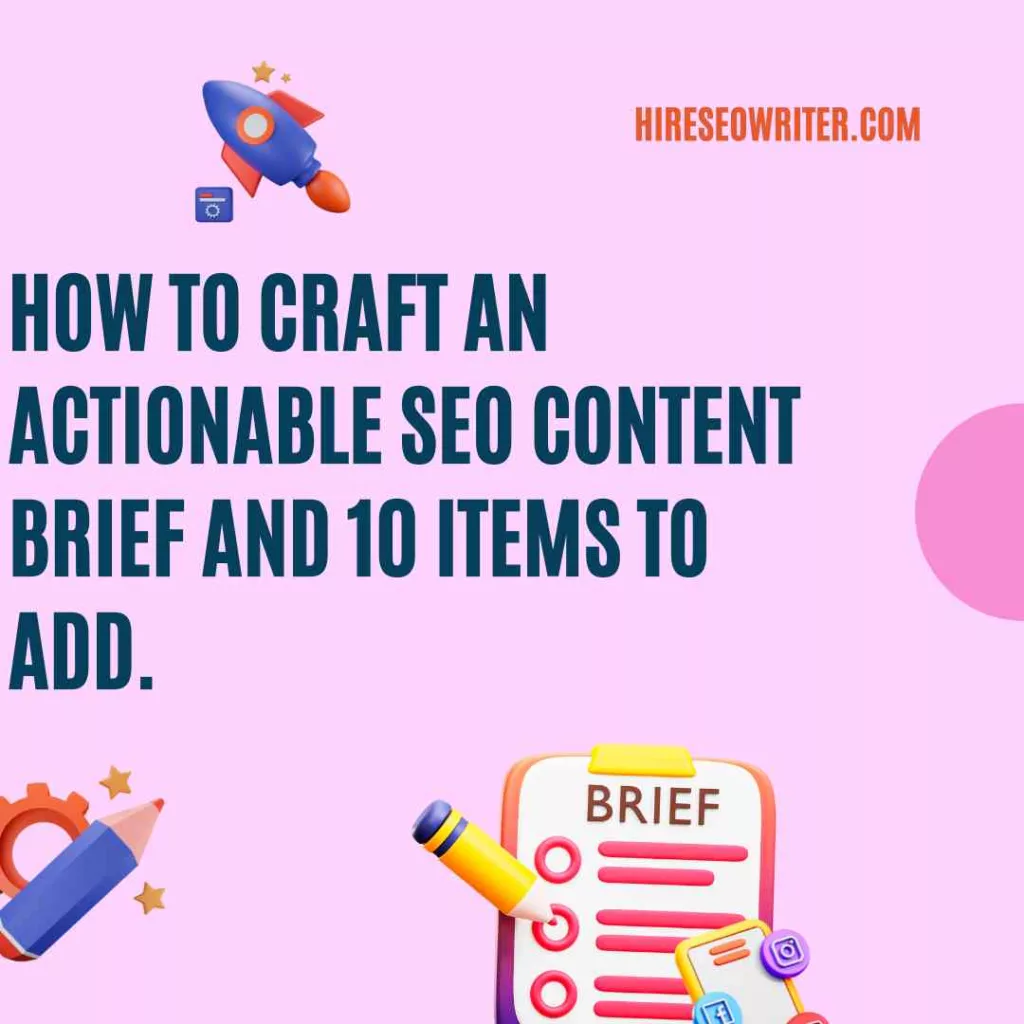Are you tired of working with freelance writers who miss the mark with their content? Or are you struggling to create effective SEO content that engages your audience and achieves your goals? The solution is simple: a clear, comprehensive SEO content brief.
Great content doesn’t just happen – it requires careful planning and methodical, goal-driven work. And even the best writers need clear, concise directions to work from. A detailed content brief can help you with that.
As someone who straddles the worlds of content and SEO, I know firsthand the importance of crafting actionable briefs that get results. In this blog post, I’ll share my top tips for creating content briefs that are both comprehensive and appreciated by your content team.
What is a Content Brief Template?
A content brief template is a structured document that outlines the goals, requirements, and guidelines for creating a piece of content. It gives a writer or content marketers a crystal road map to follow. An SEO content brief template, in particular, focuses on creating content optimized for search engines. It should include long-tail keywords, target audience information, and relevant data to ensure the content is valuable and informative.
Using a content brief template will save time and resources by providing clear direction to your content team. The template ensures that all essential elements are included. This tactic also ensures that the content meets the desired goals and objectives.
Moreover, a content brief template minimizes the risk of getting back lackluster content. The instructions and guidelines provided in the brief help writers understand the scope and focus of the content they are creating. As you’ve guessed, it reduces the need for revisions, saving time and money.
Why Use an SEO Content Brief?
Using a content brief template provides a standardized format for communicating your needs to your writers and content managers. It may be even more beneficial to you. Consider this: when you put paper to pen, that’s an act of organization. In this sense, a content brief allows you to organize your thoughts.
It also ensures that all essential elements are covered and guides your writers in creating the content you need. With a template, you can provide clear instructions on the topic, audience, content format, tone, and style of the content.
Besides, a content brief template fosters uniformity. You will streamline your content creation process and ensure consistency by giving writers identical templates. Plus, Reusing the template for related projects will enable you to cut costs and time. Genius!
In addition, SEO is an essential factor in content creation. You can ensure your content is optimized for search engines by giving SEO instructions in your brief. This will help you rank higher and get more visitors to your website.
Without a content brief, you also risk getting content that doesn’t fit your needs. This can result in time loss, frustration, and needless revisions.
In conclusion, using a content brief template effectively ensures that your content meets your expectations and accomplishes your goals. It provides a clear and concise roadmap and ensures everyone is on the same page and working towards the same objective.
Content Brief Template Components
A content brief is essential for guiding writers in creating content that meets your needs and accomplishes your goals. But what specific components should a content brief include to ensure effectiveness?
1. Target Audience
Defining your target audience is crucial in creating content that speaks to your readers. This section should include your target audience’s details, such as age, interests, and other basics. Knowing this helps me create customized and detailed content for your audience.

2. Piece of Content
Specify the type of content you want me to create, whether it’s a blog post, white paper, infographic, or social media post. When specifying the type of content you want the writer to create, it’s essential to consider your goals and your audience’s needs. For example, if you want to provide in-depth information about a particular topic, you may opt for a white paper or an e-book.
3. Target Keywords
For content producers, incorporating precise keywords into their Pieces Of Content is critical when creating SEO content. Incorporating target keywords helps in enhancing the exposure of your Content Piece in search engine results.
To achieve this, quality content briefs are essential. By focusing on keyword research and implementing them correctly, you can improve the visibility of your content at scale, ultimately driving more traffic to your website.
4. Primary and Secondary Keywords
In addition to the target keywords, specify any primary and secondary keywords that I should include in the content. I will incorporate these keywords into titles and throughout pieces to boost SEO.
Of course, nobody enjoys a robotic-sounding article. To avoid that, use keywords naturally throughout the piece.

5. Type of Content
Specify the type of content you want me to create. This could be informational, educational, entertaining, or promotional. Defining the type of content you want can help the writer to understand the purpose of the content.
For instance, if you want to create informational content, the writer will focus on providing detailed information about a particular topic. The type of content you choose can impact the tone, style, and structure of the piece.
6. Internal and External Links
Internal and external links help increase your content’s visibility and credibility. Provide specific instructions on the number of external and internal links to be included in the article.
7. Tone
It’s crucial to consider the tone of your content, as this will be the basis for how people receive your message. Defining the tone helps the writer create content that fits your brand’s personality and voice.
For instance, do you want the content to have a friendly and relaxed tone, or would you prefer a more formal and professional approach?
8. Outline
You may also choose to include an outline. An outline of your content guides the writer to structure the piece and ensure the proper placement of all essential elements. This will help them stay on track and keep the content organized logically and easily to follow.
9. Resources
You may want writers to add specific facts to your content. Provide any extra resources, such as research or statistics, upfront. This ensures that the content is accurate and provides value to your readers.
10. Deadline
To ensure timely delivery, defining a deadline for the project is crucial. This helps business owners plan their content calendar and prevents publication delays.
How to Create a Seo Content Brief Template
Now that you know the components of a content brief it’s now time to create one. Outlined below are the steps to create one.:
Step 1: Start with Keyword Research
Keyword research is the foundation of any SEO-focused content brief. Use a keyword research tool to identify the target keyword and secondary keywords for your piece of content.
To increase your chances of ranking on search engines, look for terms with a high search volume and low competition. Consider the search intent behind the target query and align your content with it.
Step 2: Analyze the Top SERPs
Reviewing the top search engine results pages for your target keyword can give you valuable insights into what types of content are currently ranking well.
Analyze the top-ranking pages’ content type, style, and structure to understand what works and what doesn’t. Use this information to create an outline for your content brief.
Step 3: Define Your Target Audience
The next step is defining who your audience is. Knowing your target audience is essential for creating compelling content briefs. Here is how you should go about it:
- Conduct Market Research: Industry research will help you to determine important aspects of your target audience. Insights to look out for are age, gender, income, and region of your target audience. To do this, use online resources like surveys, Facebook Audience Insights, and Google Analytics.
- Analyze Competitor’s Content: What kind of content appeals to your target audience? To find out, Study the content your rivals are giving. Identify what type of content gets the most engagement, shares, and comments.
- Use Keyword Research Tools: To find the search phrases and queries your target audience is using, use keyword research tools like Google Keyword Planner or SEMrush. This will help you produce content that is appealing to your target audience and optimized for search engines.
- Use Social Listening Tools: Use social media listening tools like Hootsuite or Sprout Social to monitor social media conversations and identify trends, topics, and hashtags your target audience engages.
Step 4: Add Primary and Secondary Keywords, Internal and External Links
Add the secondary and primary keywords you identified earlier to your content brief. Include internal links to relevant content on your website and external links to high-quality sources supporting your claims. Also, add a meta description, title tags, and other SEO elements to improve your content’s chances of ranking well on search engines.
Step 5: Create a Content Outline and Style Guide
Create a comprehensive outline with headings, subheadings, and key points you want to cover. Use this outline to guide your content creation process and ensure you cover all your piece’s essential elements.
Also, create a style guide that defines your content’s tone of voice, style, and voice to maintain consistency across your team of writers and content creators.
Mistakes to Avoid When Writing SEO-Focused Content Briefs
We all want our content to be successful. And you already know what to do to create a great brief. But it’s also critical to avoid pitfalls when creating your SEO content briefs. Here are some common mistakes to avoid:
Overemphasizing Keyword Search Volume
While using keywords with high search volume is great for ranking, don’t prioritize it over search intent.
At best, targeting keywords because of volume can lead to vanity traffic. They hardly convert to sales. And at its worst, you may be pitching to the wrong crowd because their search intent is not what you’re offering. Remember that your goal is to attract people most likely to convert.
Blindly Depending on Keyword Tools
Business owners should keep in mind that while keyword research tools are a valuable asset in content strategy planning, they may not always reflect the current search demand accurately.
Therefore, it’s essential to cross-check your suggested keywords with other tools, such as Google Trends, to ensure you have the latest data at your disposal. To create a comprehensive content outline, consider using a white paper to determine your brand’s unique tone of voice and specific content needs.
Keyword Stuffing
Your SEO content brief should have primary and secondary keywords. Still, it’s crucial not to instruct your team of writers to focus solely on including key phrases a specific number of times. This could lead to keyword stuffing–which Google frowns at.
Instead, focus on making the content answer your audience’s questions. It should address concerns related to your keyword. That way, search engines know what your content is about while satisfying your website visitors.
Critical Elements for a Successful SEO-Focused Content Creation Process
Creating content for SEO purposes is an integral part of any content marketing strategy. Your website content must be optimized for search engines. To do this effectively, you should include certain key elements in your content creation process.
Keyword Research
Before creating any Piece Of Content, it’s important to conduct keyword research to identify the best keywords or phrases that will be most effective for targeting potential customers who use search engines like Google or Bing.
Quality Writers
When creating SEO-focused content, having quality content writers is crucial to your success. High-quality content engages your readers and signals to search engines that your website is authoritative and relevant to a particular topic.
However, finding a suitable writer to meet your content creation needs can be challenging. This is where Hireseowriter can be a game-changer.
Submitting your comprehensive outline to me means that you can expect your top-ranking pages to be updated with high-quality content within a few days. This approach ensures that your website remains up-to-date without taking away your focus from other crucial aspects of your business.
Strategic Content Promotion
The final step in a successful SEO-focused creation process is content promotion. This involves promoting all created content strategically across multiple platforms. These platforms may be social media sites (Twitter, Facebook, etc.), email newsletters, blogs, directories, forums, etc.
As a Content Strategist, determining the ideal platform for publishing your content hinges on where your target audience frequents the most. This approach not only enhances visibility but also facilitates direct engagement with your audience through comment section responses, direct messages, and more.
To optimize your content for search engines, it’s crucial to incorporate Long-Tail Keywords that align with the Search Intent of your audience while maintaining an appropriate Average Word Count.
Conclusion
The benefits of content briefs are immense. It will make it easier for your writing and marketing teams to sync. It ensures that the pieces of content you get back are connected, smooth, and consistent.
But after creating the perfect content brief, what next? It’s up to you to ensure your content is of the highest possible quality. I can help you guarantee that outcome. Get in touch today.

